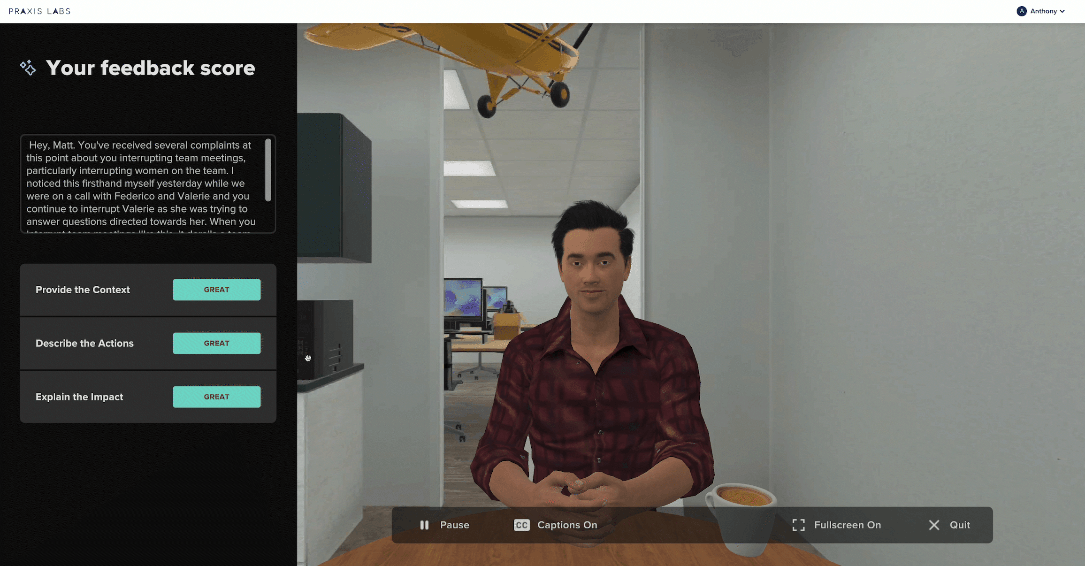- DEIJ
How People Leaders Can Use Data and Analytics to Drive DEIJ Impact: Q&A with Elise Smith
HR Exchange brought together Praxis Labs Co-founder & CEO Elise Smith and Syndio CEO Maria Colacurcio for a thought-provoking conversation about how to bring data and learning together to create meaningful outcomes for diversity, equity, inclusion, and justice (DEIJ) initiatives.
In part one of this Q&A, read what Elise has to say about Praxis’ philosophy of the workplace, how DEIJ impact drives business value, the power of immersive learning, and much more. Then, check back for part two, where Maria delves deeper into analytics, intersectionality, and pay equity.
Maria Colacurcio: To start, what brought you to this work? What does workplace equity and inclusion mean to you?
Elise Smith: Diversity, equity, inclusion, and justice work is personal work for me, not just because of my lived experiences, but those of my family.
When I think about what an equitable and inclusive workplace looks like and what it means, I like to unpack what we’re all driving towards: The goal is to have a more just workplace and a more just society. How we get there is by removing the barriers to equity and inclusion, and really driving towards better outcomes for everyone.
That’s not just for the people who work in our companies, but for the people we’re serving as well. We remove those barriers by first identifying what they are, then by uncovering gaps and the distance that we need to travel to close them.
And it all boils down to investing in our people to achieve those goals. This is something we’ve thought deeply about at Praxis Labs. How do we embed equitable and inclusive policies, practices, systems, and structures from the very beginning of our company?
It’s not just about hiring diverse teams — although that’s a great place to start. It’s ensuring that we can support those teams across the employee lifecycle by giving them the tools and access points they need to progress in their careers and feel like they belong. The way we do that is by offering training and development.
Working across differences and knowing how to show up in difficult conversations is not something we innately know how to do. So we need to provide more opportunities to learn and to lean into these types of empathetic, human-centered leadership.
The bottom line is that equitable and inclusive workplaces work for everyone. They steer us towards a future of work where people feel valued enough to bring their authentic selves to work, and in turn bring their best and brightest ideas. That’s where teams get their competetive edge.
MC: How do you address the argument that this is just “woke capitalism?” That DEIJ isn’t fundamental for businesses and organizations to get better or be more durable, more profitable, or able to overcome the volatility that’s currently happening. How do you respond to that?
ES: Often, workplaces are the most diverse spaces we enter — the first time we have to interact and work across differences. Sometimes people think about diversity, equity, inclusion, and justice (DEIJ) training as only helping folks who come from underrepresented backgrounds or marginalized identities. I think that’s the wrong way of looking at it, because DEIJ work is really about helping all people collaborate and work better together.
DEIJ is about helping us feel comfortable expressing our ideas, understanding barriers that prevent people from reaching their potential, and creating and challenging each other so that we can have the best outcomes. It’s about being more innovative, more profitable, and more durable.
It all starts with human skills that we often refer to as “soft” skills. It starts with being able to step into a courageous or difficult conversation and acknowledging intersectional identities and systems of structure and power when they’re at play. It’s also being able to feel confident in those conversations and in making decisions knowing that you aren’t causing harm.
I hear the concern around “woke capitalism” that it’s “just one more thing to do.” But really it is all about driving value — because people success is business success
MC: What do you think about data and training working hand in hand? Especially because you are doing this immersive experience that’s so different from the one-off training that is immediately forgotten. Can you talk about what you’re seeing from some of your clients’ experiences?
ES: Often, asking folks to invest even more of themselves into the workplace to achieve inclusive outcomes can feel like a lot. That’s why it’s important for L&D and DEI leaders to make learning personally and contextually relevant to learners. And they also want to know that their investment will yield meaningful results.
That’s why our approach to training and development starts with the evidence. What’s in the research? What are we seeing academically in practitioner work? What are interventions that are actually proven to move the needle on DEIJ?
Then, instead of the one-and-done training format that we know doesn’t work, we develop continuous and reinforced learning and practice moments, which are directly tied to long-term memory building and connecting learning theory to real-world action.
Data and analytics is integral to this work. We look at not only how folks are progressing in and completing content, but how they’re growing on our competencies and how they’re feeling about their workplaces’ culture and policies.
We put folks in the driver’s seat by giving them self-directed learning. They’re able to go through workplace scenarios and practice encountering barriers to equity as themselves, as a bystander, and as someone complicit in the incident. They get to practice self-advocating or advocating on behalf of others as an ally or upstander, as well as repairing harm after making a mistake.
The immersive experience of going through multiple perspectives in workplace scenarios is really core to building empathy for experiences different from your own. It’s also core to being able to identify barriers to equity in the workplace, as well as being able to actually intervene in the moment.
Beyond learning and practice, we get a lot of feedback from our partners around employees’ experiences within their workplaces. We ask how they want to see equity and inclusion prioritized, and then we’re able to give feedback to that client, and further break down those insights by demographic factors such as race, age, and gender..
For example, one of our clients used our platform data to realize that Black and Latinx women weren’t accessing mentorship and sponsorship opportunities the same way other demographics are. Equipped with this data, leaders were then able to ask: how can we create and invest in those communities and ensure they can take advantage of growth opportunities?
It’s also about understanding how you can use existing pulse surveys and people analytics to measure learning impact. One of our clients was able to filter a recent employee engagement survey by managers who went through our training compared to managers who didn’t. They looked at differences in inclusion surveys, engagement scores, and how their teams felt.
They found that folks who went through our trainings were more likely to practice inclusive and equitable behaviors and create teams that feel more included. The ultimate result was people who feel like they belong, and who are more likely to stay and recommend others to work there.
MC: I’d also like to ask about folks that have been the recipients of consistent microaggressions or have been in situations where they don’t feel as included or as if they belong. What happens to them, in terms of engagement, when they watch their leaders or their colleagues go through this training and actually start to change?
ES: As a Black woman myself, I don’t always feel comfortable standing up and then naming when something’s amiss. Being aware of those moments helps me understand areas that I can improve and be a better advocate for myself and on behalf of others.
What we hear from a lot of folks who share similar intersectional identities of the characters in our learning experiences is the value of being seen and validating their lived experiences. Being seen is one of the most powerful ways that you can feel that you belong and that you’re included.
Another thing that we hear from these learners is that they feel like a burden was removed from them. So often when you come from a marginalized identity, there is a burden of proof that you are experiencing mistreatment in your workplace.
You are sometimes asked to share out trauma, to share out pain, to share out moments of bias or discrimination for the education of your colleagues. Many of our learners say that it’s such a relief to not have to play that role, that these immersive experiences can help with that education and empathy-building.
Lastly, it’s about practice. It’s not just building up the muscle to self-advocate. It’s also about having conversations with your colleagues and teams about why self-advocacy isn’t always a solution. We often need to zoom out from the interpersonal level to focus on systems and structures, and how those can be improved to support equitable and inclusive workplaces.









